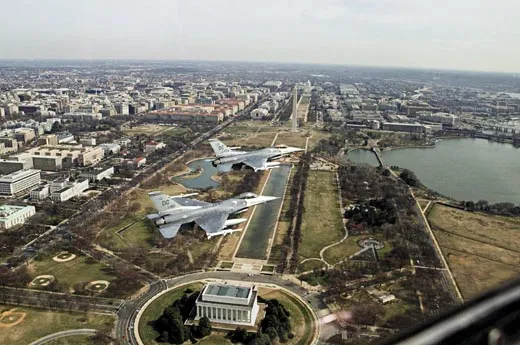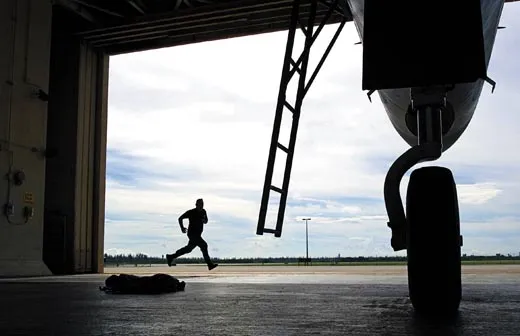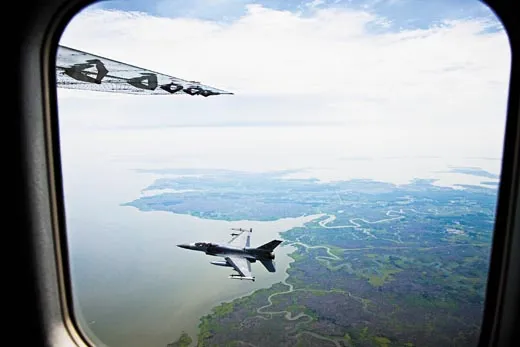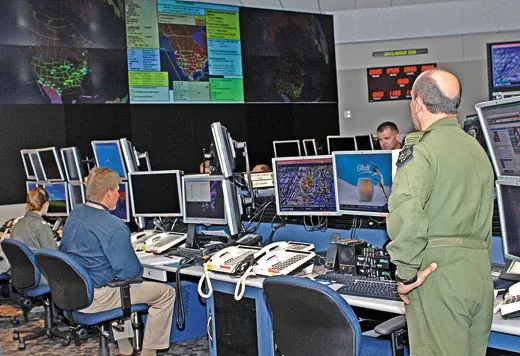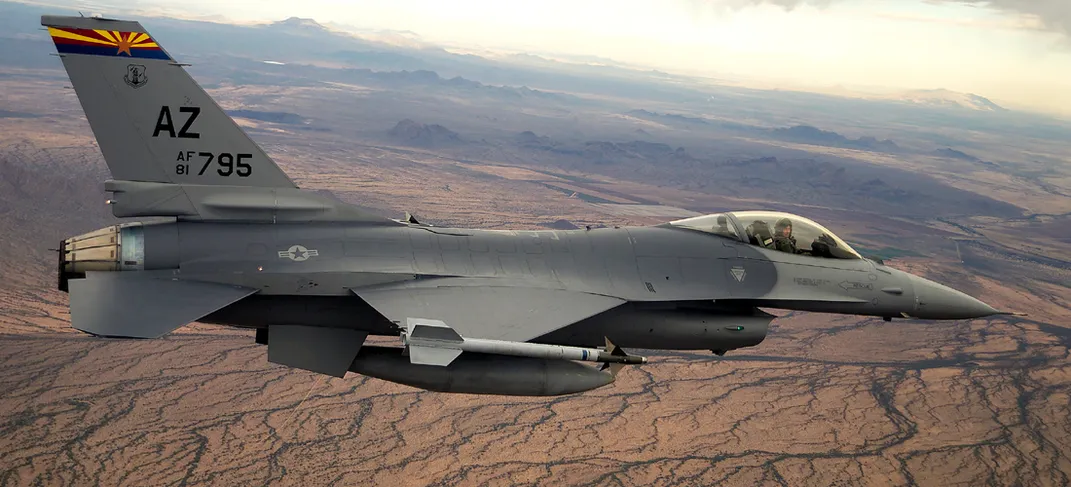Would a Fighter Pilot Shoot Down a Private Airplane?
Interceptions over restricted airspace—mostly of innocent civilians—are more common than you’d think
/https://tf-cmsv2-smithsonianmag-media.s3.amazonaws.com/filer/7a/ae/7aae5717-b944-408b-b9a8-ca9bdf13a29a/f-16_arizona_national_guard.jpg)
The eight-seat recreational airplane, a single-engine Gippsland Airvan, is cruising peacefully over southern Maryland on a hazy June afternoon, pilot and passengers enjoying the view from 4,000 feet, where the Nanticoke River runs into the swamplands at the edge of the Chesapeake Bay. Suddenly—whoosh! A trademark shape most of us encounter only in the movies or at airshows darts underneath the 100-knot pleasure craft, then carves a semi-circle in the sky in front of it. A voice crackles in the pilot’s headset: “This is a United States Air Force armed F-16. You are in violation of restricted airspace. Do you require any assistance?”
No response from the Airvan. A minute or two later, the fighter is back, aiming for a more dramatic impression. It executes the “head butt,” soaring up vertically within 500 feet of the intruder’s nose. The voice in the earphones sounds less helpful this time: “This is a United States Air Force armed F-16. You have been intercepted. Please acknowledge or rock your wings.”
The jet and an unseen wingman have scrambled from Andrews Air Force Base, just east of Washington, D.C. But their controllers sit 400 miles north, outside the faded Erie Canal town of Rome, New York, amid a forest of glowing monitors at the headquarters of the Eastern Air Defense Sector (EADS). Yellow blips track every aircraft aloft east of the Mississippi River, several thousand on a typical weekday afternoon like this.
A general aviation airplane without a flight plan, chugging into restricted airspace, does not take long to stick out from the herd. If the Airvan continues to ignore the fighters in its face, EADS will pass an alert up a chain of command, where unspecified persons will have to decide what to do about it, perhaps within minutes, if the off-course pilot swings west toward the nation’s capital.
This particular interception turns out to be a dress rehearsal. The Airvan’s pilot and copilot are Bill Parris and Michael Regen, two Civil Air Patrol volunteers on a day off from their real jobs, as radio station owner and restaurant supply wholesaler. The routine is choreographed in advance with the Andrews top guns. “Nice work, braves,” Parris compliments the F-16 pilots as the passenger airplane peels off toward its home hangar, at Martin State Airport near Baltimore.
This was practice, but the real thing happens often enough. One of the few detailed studies on the subject, a 2005 Government Accountability Office (GAO) report, found 3,400 violations of restricted airspace, or about three a day, in the 39 months following the September 11, 2001 terrorist attacks, which rewrote the rules of U.S. aviation. About 88 percent of the offenders were general aviation pilots, and seven percent were military. The most common reasons for infractions were pilots altering flight plans to avoid bad weather, or not keeping up to date on the shifts and expansions of the government’s no-fly zones. The zones can change with little warning, as when the president travels. Nearly half the violations—43 percent— tallied by the GAO were in the Washington, D.C. area.
Most violators, of course, respond to a radio warning from Federal Aviation Administration controllers, and if not to that, then to the bright red and green lights used to flood the cockpit of intruders in the vicinity of Washington, and if not that, then to the Coast Guard Dolphin helicopters that sometimes precede the jet fighters. All the same, military aircraft have engaged interlopers “hundreds of times” over American skies since 9/11, says Davi D’Agostino, the GAO’s director of Defense Capabilities and Management. And defenders cite at least three cases last year alone when they feared they would be ordered to apply the ultimate sanction: annihilating a general aviation aircraft to stop it from committing a presumed terrorist act.
On April 6, 2009, what turned out to be a mentally disturbed young Canadian pilot entered U.S. airspace over Lake Superior without warning, and led Air National Guard F-16s on a five-hour chase over four states before finally landing on a country road in Missouri. Minnesota Air National Guard pilots were the first to intercept the Cessna 172 near Michigan’s Upper Peninsula. National Guard units from Wisconsin and Louisiana took over as the pilot continued south without responding to the military jets.
Failing to raise the off-course Cessna 172 on the radio, the F-16s tried to get the pilot’s attention: firing flares in front of the renegade aircraft and flashing their landing lights. When the Cessna came within five miles of downtown Madison, the governor, on the recommendation of the Wisconsin homeland security advisor, ordered the state capitol building evacuated.
The Missouri state troopers who arrested Adam Leon reported he was trying to commit suicide. “If he had turned toward Chicago, he would have gotten his wish,” says Gary Miller of the Federal Aviation Administration’s Office of Tactical Operations Security, who monitored the slow chase. “That’s the closest we’ve ever come to shooting down somebody on my watch.”
Just 18 days later, Maine retiree William Wales, flying down to see his daughter in North Carolina, strayed over Washington, D.C.’s restricted zone. Though repeatedly hailed on emergency frequencies by F-16s, he failed to respond, prompting a lock-down at the White House, preparations to evacuate the Capitol, and frayed nerves at EADS, whose staff flagged the incident to the North American Aerospace Defense Command (NORAD) in Colorado and braced for an order to fire. “Everything looked to be going against this man for a while,” says Air Force Master Sergeant Michael Roberts, who was directing the interceptors from his chair in Rome that day. Wales finally saved himself when a Coast Guard helicopter flew by with a light board, a sort of neon sign, ordering him to call a certain radio frequency. He did, and was escorted to an airstrip out of harm’s way.
Last September, NORAD sent F-16s after a Mooney M20M that lost contact with controllers over Michigan and subsequently crashed near Muncie, Indiana. Military officials reported that the hobby pilot was apparently unconscious in his cockpit. He died in the crash.
Some people might say that sending a $15 million fighter designed to outduel Soviet MiGs to interdict an off-course Piper Cherokee is using an awfully big hammer to hit a pretty small nail. These days, terrorism experts do not rank kamikaze attacks by general aviation airplanes high on their list of concerns. “You could do more damage with a Ryder truck full of fertilizer,” says James Jay Carafano, a homeland security expert at the Heritage Foundation in Washington. When domestic airspace does need to be protected, other tools are more appropriate, he says, from helicopters to ground-based weapons.
Interceptions by military jets are not cheap. Flying an F-16 for an hour costs the taxpayer $1,711, according to John Salvador, head of the Civil Air Patrol’s Missions Directorate. Not to mention the hours of practice beforehand. A major focus of F-16 pilots’ interception training is learning to slow their high-performance jets enough to read the tail numbers on pleasure craft going one-fifth their speed.
But few complain about the cost. Since 9/11, the U.S. government has been in no mood to take chances in the sky, or assume suicide pilots won’t destroy their targets. “A little Cessna with 250 pounds of explosives behind the pilot is all it would take to ruin Washington’s day,” growls the FAA’s Miller, mindful of the psychological as well as the physical effect that such a crash might have.
So, as the nation clamored for security after the attacks nine years ago, the Department of Defense launched Operation Noble Eagle, to expand its zone of protection from the U.S. border to the entire domestic sky. Pilots at Andrews and other bases across the land started drilling in deceleration and tail-number-reading. The FAA cordoned off protected air pockets over such potential targets as Disneyland and NASA’s Johnson Space Center. The rules aren’t always absolute. The FAA “strongly advises” pilots to avoid flying over power plants, dams, and refineries “to the extent practicable.” A short list of flat no-fly areas within the United States includes the houses of both ex-President Bushes, in Crawford, Texas, and Kennebunkport, Maine, and the Pantex nuclear assembly plant in Amarillo, Texas.
No city, not even New York, has the level of protection afforded to Washington. The nation’s capital boasts two concentric rings of restricted air traffic. The outer one is (or was) called the ADIZ, for Air Defense Identification Zone, which after a bit of pulling and tugging is now a simple circle of 30 miles radius with Reagan Washington National Airport at the center. Just as aviators were getting used to the term ADIZ, the government changed its name in 2008 to SFRA—Special Flight Rules Area. Whatever you call it, in order to fly there, pilots have to file a flight plan with the FAA and obtain a four-digit transponder code for communications with controllers.
The inner, 15-mile circle around Washington is the Flight Restricted Zone, or “Freeze.” Three general aviation airports are still in business within the FRZ, but all pilots flying within the zone must be pre-certified. At Reagan National this involves finger-printing and background checks. Then there is the dreaded P-40, a circle around Camp David, the president’s retreat, 65 miles north of Washington, that is normally three miles in radius but expands to 10 miles when the president—or POTUS (president of the United States), as they call him in the bunker at Rome—is there. The FAA also regularly issues TFRs, or Temporary Flight Restrictions, most commonly linked to a POTUS visit to another part of the country. These are broadcast by NOTAMs (Notices to Airmen, a sexist holdover), which every pilot is theoretically required to consult before he or she takes to the air.
All the new regulations have collided head-on, metaphorically speaking, with the prevailing “Don’t tread on me” culture of general aviation, in which pilots cherish their airplanes as an embodiment of personal freedom. At Maryland Airport, a grass strip surviving among suburban McMansions in the town of Indian Head, just south of the FRZ, co-owner Gil Bauserman delivers a lengthy harangue against the federal “Gestapo” that terrorizes innocent fliers and is burying his business in red tape. “We had a retired Navy captain who lost electrical [power] and got intercepted because he couldn’t talk on the radio,” he recounts. “All of a sudden you have people jumping out of a Blackhawk helicopter with M-16s and the Indian Head sheriff’s department taking him down to interrogate him.”
The new rules are oppressive in subtler ways too, says Bauserman, who shoots the breeze in the airport’s haphazardly furnished office with his father and son, who are also his business partners. “So-called intentional violation of the SFRA is a felony,” he rails. “That means a lot of our customers, who are government or military employees, could lose their jobs. But how often does somebody drive down the road and take a wrong turn?”
The testy rhetoric is harmless enough. But could a misunderstanding between defenders and aviators one day turn tragic, with some combination of failed equipment, pilot cluelessness, and itchy fingers in the Air Force leading to the death of a harmless hobbyist and collateral damage to anything in his flight path?
Military commanders acknowledge that there are specific triggers for destroying civilian aircraft, but they will not disclose them. Presumably they involve several factors, from type of aircraft to flight path to behavior of the pilot. “There are very detailed rules of engagement to which we train on a routine basis,” Paul McHale, assistant secretary of defense for homeland defense, told the Defense Writers Group in 2005. He stressed that any decision to fire would not be made by the pursuing military pilots or their immediate handlers at Rome. “The authority to shoot down a civilian aircraft is delegated to a very small number of very senior officials, civilian and military, within the Department of Defense,” McHale said.
The GAO’s D’Agostino assumes the circle is smaller still. “It would have to be the president or the Sec Def making the decision,” she says, employing Beltway-speak for the Secretary of Defense. “The U.S. military does not relish the thought of shooting down civilians.”
Last spring’s five-hour pursuit of the intruding Canadian shows the forbearance of the nation’s airborne defenders, and the wealth of information they can access quickly about a pilot’s background and even state of mind. While the F-16s stuck with the aircraft, the FAA went to work identifying the violator from his tail number. He went by both his original Turkish name, Yavuz Berke, and the Anglicized Adam Dylan Leon. At one point, the FAA brought in an FBI hostage negotiator to try (in vain) to talk the pilot down. Unnamed intelligence agencies cobbled together a quick psychiatric profile. Last August, the 31-year-old pleaded guilty to stealing an airplane and entering the United States illegally and was sentenced to two years in federal prison.
The unnerving part of the intercept picture is that, for all the whiz-bang technology at EADS, making judgments about objects in the sky while sitting on the ground still involves plenty of guesswork. The FAA’s Miller reports that more than once Andrews F-16s have scrambled to arrest flocks of birds, particularly during autumn migrations.
Lt. Col. Paul Bishop, one of the EADS officers who take turns commanding 15 or so Air Force personnel in the LED-lit war room at Rome, recalls dispatching warplanes to intercept a speeding tractor-trailer on Interstate 90 in western New York state. EADS had picked up the truck on its radar scopes. On another occasion, F-16s were dispatched to a Temporary Flight Restriction zone set up to protect a space shuttle launch, and discovered a runaway Mylar balloon.
Less comically, the FAA shut down National Airport last winter and alerted the military that an unidentified “ultralight aircraft” from the west was approaching it and the nearby Pentagon. The threat turned out to be a group of George Washington University students launching a hang glider in poor visibility at dusk.
On other occasions, officials have been slow to react. When a pair of Northwest Airlines pilots infamously overshot the Minneapolis airport by 150 miles last October—distracted by working on their laptops, they claimed—jet fighters were on standby, but never ordered into the air. Military officials said later that the FAA delayed notifying them.
What’s certain is that even people who should know better continue to do stupid things in airplanes. Scouring his screens on an otherwise uneventful morning at EADS, Roberts spots an aircraft off the coast of Louisiana. There’s something wrong: The airplane is using the generic transponder code 1200, forbidden in restricted flight zones—like this one, used for military maneuvers. If the situation isn’t resolved in, literally, a minute, Bishop says he will have to declare an “unknown” and clear the room of non-essential personnel. But then the careless military pilot corrects his error.
A more obdurate intruder speeding toward Capitol Hill or Orlando, rather than wandering aimlessly around the Midwest, would force authorities to make choices quickly. A humble Cessna 172 can fly up to 140 mph, so from first breach of Washington’s outer 30-mile security zone, the pilot could hit the Capitol or White House in less than 15 minutes. Even if the POTUS is not banqueting with foreign dignitaries and the Sec Def is not playing racquetball, neither would have much time to make one of the most important decisions of their lives.
The bureaucratic flow chart for handling such emergencies looks more suited to lengthy debate than quick judgment calls. At least half a dozen federal agencies—the Department of Defense, the FAA, the Transportation Security Administration, Customs, the Secret Service, and the FBI—would have to consult in either of two electronic forums: the Domestic Events Network or the National Capital Region Coordination Center. The GAO report found one small problem: None of them was designated the lead agency.
When the auditors suggested to Congress that someone be put in charge, the Pentagon, straining English as only it can, “nonconcurred.” Each agency has its own role to play, the defense department argued, and should not take a back seat to another for even 15 minutes. The military did fix other glitches identified by the GAO, like getting top FAA officials clearances so that NORAD software would not lock them out of kill-or-no-kill discussions. But the DEN and NCRCC remain leaderless to this day.
Frontline defenders of the skies seem slightly less reluctant than their commanders to pull the trigger in ambivalent circumstances. The crew members at EADS were pained by their inability to prevent the September 11 attacks, even though at the time monitoring domestic air traffic was not an Air Force mission. The welcome video shown to Rome’s rare visitors dwells in almost lurid detail on the terrible events at the World Trade Center. The staff is grimly determined never, ever, to let anything of the kind happen again. “If the order comes to terminate one of these situations, I want to be the one in the chair,” Roberts says. “Any of us would. That’s what we’re trained for.”
“We try to scale back the DoD,” says the FAA’s Miller. “They like to be forward.”
Even military intercept missions that never come to the point of shooting can be dangerous, according to some civilians. “Having an F-16 fly past a GA plane and fire flares is a good way to start a fire,” says David Wartofsky, co-owner of Potomac Airfield, one of the general aviation strips still operating within the FRZ.
Maryland Airport’s Bauserman claims to have witnessed a near-collision between a Coast Guard helicopter and a Piper Cherokee 140 it was escorting to the ground (the Cherokee’s pilot happened to work at the Transportation Security Administration). “The helicopter was in the Cherokee’s path when it made a left turn to land, and the helicopter pilot had to fly underneath it to get out of its way,” Bauserman recalls.
Yet even these libertarians admit that airborne security has become less heavy-handed with time. For one thing, the role of the F-16s’ helicopter adjunct is no longer carried out by hard-ass Customs and Border Protection squads in Blackhawks. “The Customs guys are used to confronting armed drug dealers and bringing a lot of force to bear quickly,” says Wartofsky. Thus the M-16s at the ready to overpower hapless hobbyist pilots. Now the helicopter mission is carried out by amiable Coast Guard crews in Dolphins. “The Coast Guard is used to rescuing ships in distress, so they are a bit more constrained.”
And some sources of confusion have been cleared up. Until August 2007, the 30-mile restricted area around Washington was an ungainly irregular shape variously nicknamed the Teddy Bear or Mickey Mouse. Now it is a near-perfect circle, harder to infringe upon accidentally. Gone too are the mini-TFRs that in the traumatized period after September 11 the FAA used to grant liberally. “For a while, any small-town mayor could call his Congressman and get a three-mile flight restriction zone declared because there was a football game on Friday night,” Wartofsky says. “It was a nightmare.”
So take heart that in the years since 9/11, there has been neither an attack nor a tragic misunderstanding. But if you are out flying, and you find an F-16 on your tail, do whatever the pilot says.
Craig Mellow is a frequent contributor.
